- Cost planning
- Cost Analysis
- Cost management Techniques
- Externally oriented Cost Management Techniques
- Relevant costs
- Short term decisions
- Risk and Uncertainty
- Linear programming – graphical method
- Linear programming the simplex method
- Multi Product CVP Analysis
- Pricing decisions and Pricing strategies
- Budgetary Control
- Performance Evaluation
- Measuring performance in divisionalised businesses
- Transfer pricing
Transfer Pricing
A transfer price is the ‘Price at which goods or services are transferred between different units of the same company’. These transfer pricing notes are prepared by mindmaplab team and covering introduction to transfer pricing, transfer costs, international transfer pricing, market-based transfer pricing, cost-based transfer pricing, the minimum transfer pricing and methods of transfer pricing management. transfer pricing short note are also available in pdf version too download.
Demand base Pricing
Elastic and inelastic demand
The value of demand elasticity may be anything from zero to infinity.
Demand is referred to as INELASTIC if the absolute value is less than 1 and ELASTIC if the absolute value is greater than 1.
- Where demand is inelastic, the quantity demanded falls by a smaller percentage than the percentage increase in price.
- Where demand is elastic, demand falls by a larger percentage than the percentage rise in price.
There are two extremes in the relationship between price and demand. A supplier can either sell a certain quantity, Q, at any price (as in graph (a)). Demand is totally unresponsive to changes in price and is said to be completely inelastic. Alternatively, demand might be limitless at a certain price P (as in graph (b)), but there would be no demand above price P and there would be little point in dropping the price below P. In such circumstances, demand is said to be completely elastic.
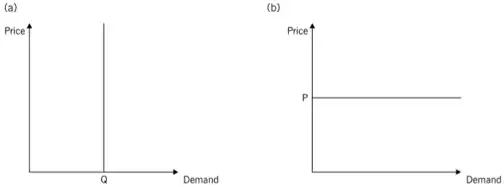
A more normal situation is where the downward-sloping demand curve shows the inverse relationship between unit selling price and sales volume. As one rises, the other falls. Demand is elastic because demand will increase as prices are lowered.
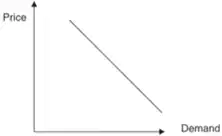
Price elasticity of demand
Price elasticity of demand is a measure of the extent of change in market demand for a good in response to a change in its price, is measured as:
The change in quantity demanded, as a % of demand
The change in price, as a % of the price
* it is usual to ignore the any minus sign
Example
The price of a good is $1.20 per unit and annual demand is 800,000 units. Market research indicates that an increase in price of 10 pence per unit will result in a fall in annual demand of 75,000 units. What is the price elasticity of demand?
Solution
Annual demand at $1.20 per unit is 800,000 units.
Annual demand at $1.30 per unit is 725,000 units.
% change in demand = (75,000/800,000) x 100% = 9.375% %
change in price = (10p/120p) x 100% = 8.333%
Price elasticity of demand = (–9.375/8.333) = –1.125
Ignoring the minus sign, price elasticity is 1.125.
The demand for this good, at a price of $1.20 per unit, would be referred to as elastic because the price elasticity of demand is greater than 1.
Elasticity and the pricing decision
- With inelastic demand, increase prices because revenues will increase and total costs will reduce (because quantities sold will reduce).
- With elastic demand, increases in price will bring decreases in revenue and decreases in price will bring increases in revenue.
- In situations of very elastic demand, overpricing can lead to massive drops in quantity sold and hence profits, whereas underpricing can lead to costly inventory outs and, again, a significant drop in profits. Elasticity must therefore be reduced by creating a customer preference which is unrelated to price (through advertising and promotion).
- In situations of very inelastic demand, customers are not sensitive to price. Quality, service, product mix and location are therefore more important to a firm’s pricing strategy.
Economic theory (Demand-based approaches) suggests that the volume of demand for a good in the market as a whole is influenced by a variety of variables such as:
- The price of the good, Tastes and fashion
- The price of other goods
- The perceived quality of the product, Expectations
- The size and distribution of household income, Obsolescence
The volume of demand for one organisation’s goods rather than another’s is influenced by three principal factors:
- product life cycle (It is characterised by defined stages including research, development, introduction, maturity, decline and abandonment)
- quality (the better quality good will be more in demand)
- marketing (including the ‘four Ps’ of the marketing mix: Price, Product, Place, Promotion)
Other (Non-financial) issues that influence pricing decisions
Non-financial issues that influence pricing decisions, include competition, quality, price sensitivity and the market in which an organisation operates.
Markets
The price that an organisation can charge for its products will be determined to a greater or lesser degree by the market in which it operates.
Competition
In established industries dominated by a few major firms, it is generally accepted that a price initiative by one firm will be countered by a price reaction by competitors. In these circumstances, prices tend to be fairly stable, unless pushed upwards by inflation or strong growth in demand.
Fighting a price war
Ways to fight a price war include:
- Sell on value, not price – where value is made up of service, response, variety, knowledge, quality, guarantee and price.
- Use ‘package pricing’ to attract customers
- Build up key accounts – as it is cheaper to get more business from an existing customer than to find a new one. Customer profitability analysis (CPA)
- Explore new pricing models
A range of other issues influence pricing decisions, including the market in which an organisation operates, competition, quality and price sensitivity, Inflation, Compatibility with other products, Competition from substitute products etc.
Deriving the demand curve
The demand curve shows the relationship between the price charged for a product and the subsequent demand for that product.
Demand curve equations
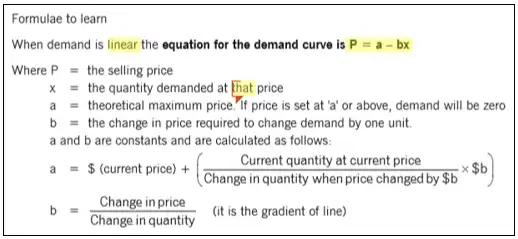
Example:
Deriving the demand curve
The current price of a product is $12. At this price the company sells 12,000 items a month. One month the company decides to raise the price to $13, but only 9,500 items are sold at this price. Determine the demand equation.
Solution
Step 1 – Find the gradient of the line (b) b = 1/2,500 = 0.0004
Step 2 – Extract figures from the question
The demand equation can now be determined as P = a – bx
b = 0.0004 x = 12,000 (number of units sold at current selling price)
P = a – (0.0004 x 12,000)
12 = a – 4.80
a = 16.80
∴ P = 16.80 – 0.0004x
Step 3 – Check your equation
We can check this by substituting $12 and $13 for P.
12 = 16.80 – 0.0004x = 16.80 – (0.0004 x 12,000)
13 = 16.80 – 0.0004x = 16.80 – (0.0004 x 9,500)
Example:
Profit maximisation and the demand curve
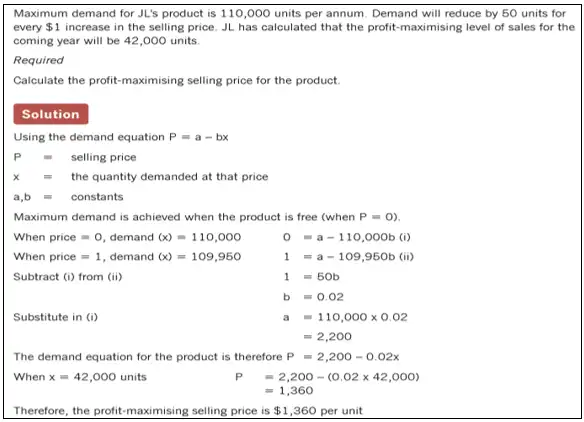
The profit-maximising price/output level
The overall objective of an organisation should be profit maximisation.
In microeconomics theory, Profits will continue to be maximised only up to the output level where marginal cost has risen to be exactly equal to the marginal revenue.
Determining the profit-maximising selling price: using equations (Algebraic Approach)
The optimal selling price can be determined using equations (ie when MC = MR).
In an exam question you could be provided with equations for marginal cost and marginal revenue and/or have to devise them from information in the question. By equating the two equations you can determine the optimal price.
Marginal revenue may not be the same as the price charged for all units up to that demand level, as to increase volumes the price may have to be reduced.
Procedure for establishing the optimum price of a product
This is a general set of rules that can be applied to most questions involving algebra and pricing.
- Establish the linear relationship between price (P) and quantity demanded (Q). The equation will take the form: P = a – bQ
- Double the gradient to find the marginal revenue: MR = a − 2bQ.
- Establish the marginal cost MC. This will simply be the variable cost per unit.
- To maximise profit, equate MC and MR and solve to find Q.
- Substitute this value of Q into the price equation to find the optimum price.
- It may be necessary to calculate the maximum profit.
Example 1 – Algebraic Approach
At a price of Rs 200 a company will be able to sell 1,000 units of its product in a month. If the selling price is increased to Rs 220, the demand will fall to 950 units. The product has a variable cost of Rs 140 per unit, and company’s fixed costs will be Rs 36,000 per month.
Required:
- Find an equation for the demand function (that is, price as a function of quantity demanded).
- Write down the marginal revenue function.
- Write down the marginal cost.
- Find the quantity that maximises profit.
- Calculate the optimum price.
- What is the maximum profit?
Solution
(1). b = (220 – 200) ÷ (950 – 1,000) = –0.4
200 = a – 0.4 × 1,000
a = 200 + 400 = 600
So the demand function is: P = 600 – 0.4Q
(2). To find MR, just double the gradient, so that
MR = 600 – 0.8Q
(3) MC = 140
(4) To maximise profit, MC = MR
140 = 600 – 0.8Q
Q = (600 – 140) ÷ (0.8) = 575
(5). = 600 – 0.4 × 575 = Rs 370
(6). Revenue = Price × Quantity = Rs 370 × 575 = 212,750
Less Cost = 36,000 + Rs 140 × 575 = 116,500
Profit = 96,250
Example 2
The total fixed costs per annum for a company that makes one product are Rs. 100,000 and a variable cost of Rs. 64 is incurred for each additional unit produced and sold over a very large range of outputs. The current selling price for the product is Rs 160, and at this price 2,000 units are demanded per annum. It is estimated that for each successive increase in price of Rs. 5 annual demand will be reduced by 50 units. Alternatively, for each Rs. 5 reduction in price demand will increase by 50 units.
Required:
- Calculate the optimum output and price assuming that if prices are set within each Rs. 5 range there will be a proportionate change in demand.
- Calculate the maximum profit.
Solution
(1). Let Q = quantity produced/sold
Demand curve
Price = a – 0.1Q
160 = a – 0.1 (2,000)
a = 360
P = 360 – 0.1Q
MR = 360 – 0.2Q
MC = 64
(2). To maximise profit: MR = MC
360 – 0.2Q = 64
P = 360 – 0.1 (1,480) = Rs 212
Revenue Rs 212 × 1,480 Rs 313,760
Less costs Rs 64 × 1,480 + Rs 100,000 Rs (194,720)
Maximum profit Rs. 119,040
Example 3
Ltd makes and sells a single product. It has been estimated that at a selling price of Rs 20, demand would be 10,000 units. It is further estimated that for every 10p drop in selling price, demand would increase by 100 units and that for every 10p increase in selling price demand would fall by 100 units. Variable costs are Rs. 8 per unit and fixed costs are Rs. 50,000.
Required: Calculate the optimum selling price.
Solution
Demand curve: p = a – bQ
b = –0.1 ÷ 100 = –0.001
P = a – 0.001Q
20 = a – 0.001 x 10,000
20 = a – 10, therefore a = 30
Demand curve is: P = 30 – 0.001Q
Marginal revenue (MR) = 30 – 0.002Q
Marginal cost (MC) = 8
Profit is maximised when MC = MR, when: 8 = 30 – 0.002Q
0.002Q = 22
Q = 11,000 units
Selling price, P = 30 – 0.001Q; at 11,000 units:
P = 30 – 0.001 × 11,000 = Rs 19
Determining the profit-maximising selling price: The tabular approach
A tabular approach to price setting involves different prices and volumes of sales being presented in a table. To determine the profit-maximising selling price:
- Work out the demand curve and hence the price and the total revenue (PQ) at various levels of demand
- Calculate total cost and hence marginal cost at each level of demand
- Finally calculate profit at each level of demand, thereby determining the price and level of demand at which profits are maximized
Example
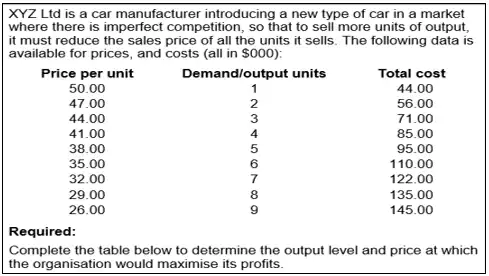
Solution
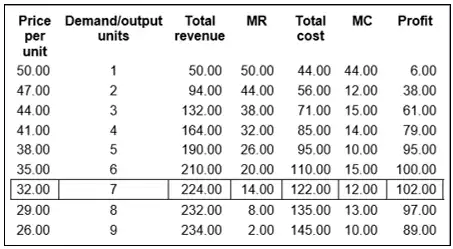
The profit is maximised at 7 units of output and a price of $32,000, when MR is most nearly equal to MC.
Cost-based approaches to pricing
Full cost-plus pricing
Full cost-plus pricing adds a percentage onto the full cost of the product to arrive at the selling price.
The traditional approach to cost plus pricing is to take the full absorption cost of a product or service and to add on a predetermined percentage mark-up to arrive at the selling price. Full cost may comprise production costs only, or it may include some absorbed administration, selling and distribution overhead as well.
Advantages
- Widely used and accepted.
- Simple to calculate if costs are known.
- Selling price decision may be delegated to junior management.
- Justification for price increases.
- May encourage price stability – if all competitors have similar cost structures and use similar mark-up.
Disadvantages
- Ignores the economic relationship between price and demand.
- No attempt to establish optimum price.
- This structured method fails to recognise the manager’s need for flexibility in pricing.
- Different absorption methods give rise to different costs and hence different selling prices.
- Does not guarantee profit – if sales volumes are low fixed costs may not be recovered.
Marginal cost-plus (mark-up) pricing
A marginal (variable) cost-plus approach to pricing draws attention to gross profit and the gross profit margin, or contribution.
Marginal cost-plus pricing/mark-up pricing – is a method of determining the sales price by adding a profit margin on to either marginal cost of production or marginal cost of sales.
Advantages
- It is simple to operate.
- It draws management attention to contribution and the effects of higher or lower sales volumes on profit. In this way, it helps to create a better awareness of the concepts of marginal costing and break-even analysis.
- In practice, it is used in businesses where there is a readily identifiable basic variable cost, e.g. retail industries.
Disadvantages
- Although the size of the mark-up can be varied in accordance with demand conditions, it is not a method of pricing which ensures that sufficient attention is paid to demand conditions, competitors’ prices and profit maximisation.
- It ignores fixed overheads in the pricing decision, but the sales price must be sufficiently high to ensure that a profit is made after covering fixed costs. Pricing cannot ignore fixed costs altogether.
Pricing based on mark-up per unit of limiting factor
It demonstrates how to calculate a price based on mark-up per unit of a limiting factor.
Another approach to pricing might be taken when a business is working at full capacity and is restricted by a shortage of resources from expanding its output further. By deciding what target profit, it would like to earn, it could establish a mark-up per unit of limiting factor.
Example
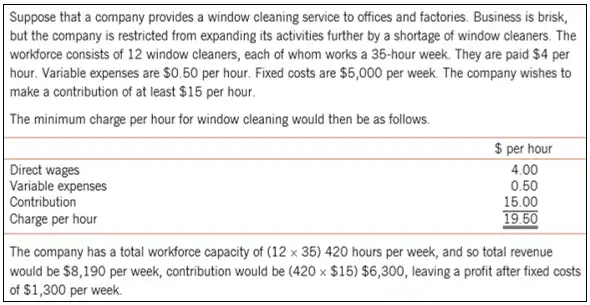
Different Pricing strategies for new products
When a new product is launched, it is essential that the company gets the pricing strategy correct, otherwise the wrong message may be given to the market (if priced too cheaply) or the product will not sell (if the price is too high).
A new product pricing strategy will depend largely on whether a company’s product or service is the first of its kind on the market.
- If the product is the first of its kind, there will be no competition yet, and the company, for a time at least, will be a monopolist. A monopolist’s price is likely to be higher, and its profits bigger, than those of a company operating in a competitive market.
- If the new product being launched by a company is following a competitor’s product onto the market, the pricing strategy will be constrained by what the competitor is already doing. The new product could be given a higher price if its quality is better, or it could be given a price which matches the competition.
Two pricing strategies for new products are market penetration pricing and market skimming pricing.
Market penetration pricing
Market penetration pricing is a policy of low prices when the product is first launched in order to obtain sufficient penetration into the market.
Circumstances in which a penetration policy may be appropriate.
- If the firm wishes to discourage new entrants into the market.
- If the firm wishes to shorten the initial period of the product’s life cycle in order to enter the growth and maturity stages as quickly as possible.
- If there are significant economies of scale to be achieved from a high volume of output, so that quick penetration into the market is desirable in order to gain unit cost reductions.
- If demand is highly elastic and so would respond well to low prices.
Penetration prices are prices which aim to secure a substantial share in a substantial total market. A firm might therefore deliberately build excess production capacity and set its prices very low. As demand builds up, the spare capacity will be used up gradually and unit costs will fall; the firm might even reduce prices further as unit costs fall. In this way, early losses will enable the firm to dominate the market and have the lowest costs.
Market skimming pricing
Market skimming pricing involves charging high prices when a product is first launched and spending heavily on advertising and sales promotion to obtain sales.
As the product moves into the later stages of its life cycle, progressively lower prices will be charged and so the profitable ‘cream’ is skimmed off in stages until sales can only be sustained at lower prices. The aim of market skimming is to gain high unit profits early in the product’s life. High unit prices make it more likely that competitors will enter the market than if lower prices were to be charged.
Circumstances in which such a policy may be appropriate.
- Where the product is new and different, so that customers are prepared to pay high prices so as to be one up on other people who do not own it.
- Where the strength of demand and the sensitivity of demand to price are unknown.
- Where high prices in the early stages of a product’s life might generate high initial cash flows.
- Where products may have a short life cycle, and so need to recover their development costs and make a profit relatively quickly.
Price Discrimination
Price discrimination is the practice of charging different prices for the same product to different groups of buyers when these prices are not reflective of cost differences.
Conditions required for a price-discrimination strategy:
- The seller must have some degree of monopoly power, or the price will be driven down.
- Customers can be segregated into different markets.
- Customers cannot buy at the lower price in one market and sell at the higher price in the other market.
- Price discrimination strategies are particularly effective for services.
- There must be different price elasticities of demand in each market so that prices can be raised in one and lowered in the other to increase revenue.
Dangers of price-discrimination as a strategy:
- A black market may develop allowing those in a lower priced segment to resell to those in a higher priced segment.
- Competitors join the market and undercut the firm’s prices.
- Customers in the higher priced brackets look for alternatives and demand become more elastic over time.
Premium pricing
This involves making a product appear ‘different’ through product differentiation so as to justify a premium price. The product may be different in terms of, for example, quality, reliability, durability, after sales service or extended warranties. Heavy advertising can establish brand loyalty, which can help to sustain a premium, and premium prices will always be paid by those customers who blindly equate high price with high quality.
Product bundling
Product bundling is a variation on price discrimination which involves selling a number of products or services as a package at a price lower than the aggregate of their individual prices. This might encourage customers to buy services that they might otherwise not have purchased.
The success of a bundling strategy depends on the expected increase in sales volume and changes in margin. Other cost changes, such as in product handling, packaging and invoicing costs, are possible. Longer-term issues, such as competitors’ reactions, must also be considered.
Loss leader pricing
A loss leader is when a company sets a very low price for one product intending to make customers buy other products in the range which carry higher profit margins. People will buy many of the high-profit items but only one of the low-profit items, yet they are ‘locked in’ to the former by the latter.
Discount pricing
Discount pricing is where products are priced lower than the market norm, but are put forward as being of comparable quality. The aim is that the product will procure a larger share of the market than it might otherwise do, thereby counteracting the reduction in selling price.
Reasons for using discounts to adjust prices:
- To get rid of perishable goods that have reached the end of their shelf life
- To sell off seconds
- Normal practice (e.g. antique trade)
- To increase sales volumes during a poor sales period without dropping prices permanently
- To differentiate between types of customer (wholesale, retail and so on)
- To get cash in quickly
